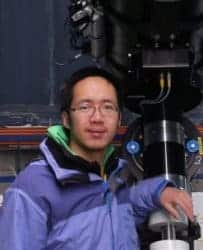 One mission two spacecraft, China is going back to the Moon with Chang’E 4 mission that I think is the most exciting lunar mission since the 1970s. By the end of 2018, the China National Space Administration (CNSA) will launch Chang’E 4 that will explore the far side of the Moon with a lander and a rover. Since it is on the other side of the Moon, it will be totally out of sight from the Earth. To facilitate communication, a relay satellite will be launched in advance of the lander/rover’s arrival at the Moon.
One mission two spacecraft, China is going back to the Moon with Chang’E 4 mission that I think is the most exciting lunar mission since the 1970s. By the end of 2018, the China National Space Administration (CNSA) will launch Chang’E 4 that will explore the far side of the Moon with a lander and a rover. Since it is on the other side of the Moon, it will be totally out of sight from the Earth. To facilitate communication, a relay satellite will be launched in advance of the lander/rover’s arrival at the Moon.
In addition to engaging private sector companies in China, Chang’E 4 will include a significant level of international collaboration, with payloads from Germany, the Netherlands, Saudi Arabia, and Sweden.
Ye Quan-Zhi is a postdoc astronomer who specialises in small bodies in the solar system. Like me, he started off as an amateur astronomer but now uses telescopes with apertures measured in meters rather than inches! In addition to his research, he writes about space in the Planetary Society’s blog. As a Chinese national, Quan-Zhi has an interest in and insight into the Chinese Space Programme, and in this episode, we spoke about the upcoming Chang’e E-4 mission and the prospects of collaboration between India and China in space.
Change’ E 4 Mission – An overview
Relay Satellite
Named as “Queqiao” or magpie bridge, it will be launched in May 2018 and placed in the Earth/Moon L2 orbit (also known as a halo orbit) about 60,000km from the Moon (450,000 km from the Earth) in the opposite direction of the Earth. From there, it will always have a line of sight to the far side of the Moon and Earth at the same time. Its primary purpose is to act as a relay providing all the communications from the Lander/Rover that will land on the Moon in late 2018 or early 2019.
The two microsatellites from the Netherlands are called “Longjiang-1″ and “Longjiang-2”. They will enter an elliptical lunar orbit and conduct low-frequency radio astronomy experiments.
Lander & Rover
Due for launch in December 2018 or early 2019
The lander and rover are backups to the highly successful 2013 Chang’E 3 mission. Whilst identical in most respects, lessons learnt from Chang’E 3 have been incorporated in modifications to Chang’E 4.
Lander
• Landing Camera (LCAM)
• Terrain Camera (TCAM)
• Low-Frequency Spectrometer (LFS) to investigate radiation bursts from the sun and cosmos.
• Lunar Lander Neutrons and Dosimetry (LND), a neutron detector from the University of Kiel in Germany
• A mini “lunar biosphere” experiment designed by 28 Chinese universities, consisting of a 0.8 litre capacity enclosure weighing 3 kilograms. The biosphere contains silkworm eggs and seeds for cress and potatoes. Once on the lunar surface, this mini biosphere will maintain a humidity and temperature (1 to 30 degrees centigrade) whilst the lunar surface temperature varies from +100 to -100 degrees centigrade. An HD camera will live-stream from the lunar surface, showing the hatching eggs and sprouting seeds during the first two weeks of the mission.
Rover
• Panoramic Camera (PCAM)
• Ground penetrating radar (LPR) to investigate the lunar crust and mantle
• Visible and Near-Infrared Imaging Spectrometer (VNIS), for imaging spectroscopy
• Advanced Small Analyser for Neutrals (ASAN), to investigate how solar particles interacts with the lunar surface.
Podcast: Play in new window | Download (Duration: 43:06 — 59.1MB) | Embed
Subscribe: Apple Podcasts | Spotify | RSS | More
Leave a Reply